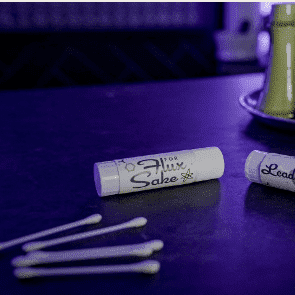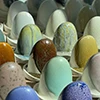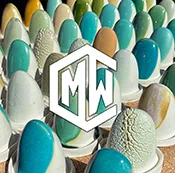Hey there, ceramic enthusiasts! Let’s tackle a topic that often causes confusion and concern: lead in ceramics. It’s time to clear the air and separate fact from fiction, so you can confidently create and enjoy your pottery!
Mythbusters: Debunking the Lead Scare
First things first, let’s put your mind at ease.
Handmade and small-batch functional ceramics made in the United States do not use lead in their production.
This practice has been in place for decades, ensuring that your handcrafted mugs, bowls, and plates are lead-free and safe for everyday use.
Even major dinnerware companies in the US, like Fiestaware, stopped using lead in their products way back in 1986. So, if you’re buying new ceramics from reputable sources in the US, you can be confident that lead isn’t an issue.
We even visited Fiesta Dinnerware factory in Newell, WV! Read more here!
Lead: Understanding the Real Risks
While lead has been a serious problem in other industries (think paint, gasoline, and plumbing), its presence in modern ceramics has been largely mitigated through strict regulations and responsible manufacturing practices.
Social Media Sensationalism: Don’t Believe the Hype
Unfortunately, fear-mongering on social media has created unnecessary panic about lead in ceramics. It’s crucial to remember that lead is naturally present in our environment, and even with meticulous testing, trace amounts can be detected.
The Role of Lead in Glazes
Historically, lead was used in ceramic glazes as a flux, lowering the melting point of silica (the main component of glass). However, it’s important to note that:
- Lead is a Minor Player: Even in older glazes containing lead, it makes up only a small percentage of the overall composition. Silica is the dominant ingredient.
- Transparency Isn’t a Telltale Sign: Contrary to popular belief, a glaze’s or glasses transparency doesn’t indicate the presence or absence of lead. All glazes are inherently clear; it’s the clay body that determines opacity.
Curious about what those glaze labels are even talking about? Read our article: Demystifying Ceramic Glaze Labels
FDA Regulations: Keeping You Safe
The Food and Drug Administration (FDA) in the United States has strict regulations regarding lead levels in dinnerware. These regulations ensure that ceramics are safe for consumers.
But… Should I be afraid of lead leaching? Listen to CMW’s podcast For Flux Sake: Episode 61, Should I be afraid of lead leaching?
Testing for Lead: The Science Behind Safety
- The Acid Test: To determine lead levels, ceramics are soaked in a 4% acetic acid solution for 24 hours, simulating the acidic conditions of food and beverages.
- Lab Analysis: The solution is then analyzed to measure the amount of lead released.
- Allowable Limits: The FDA sets different limits for different types of dinnerware:
- Flatware (plates, bowls): 3 milligrams of lead per liter.
- Cups, mugs, pitchers: 0.5 milligrams of lead per liter.
You can’t always trust the at home lead testing kits: Learn more here!
The Takeaway: Knowledge is Power
The key takeaway is that the presence of lead itself isn’t the issue; it’s the amount that can leach out and potentially harm human health.
Properly designed, fired, and tested ceramics pose minimal risk to consumers.
By understanding the facts and staying informed, you can confidently create and enjoy your ceramic masterpieces!
Next Step: Why do pots get hot in the microwave? | For Flux Sake: Episode 82
Ready to dive deeper?
Loved learning about ceramic glazes? Want to go even deeper? Check out our Workshops & Courses, now available in Spanish, or YouTube Channel where Matt breaks it all down, myth-busting and Stull chart included!



















